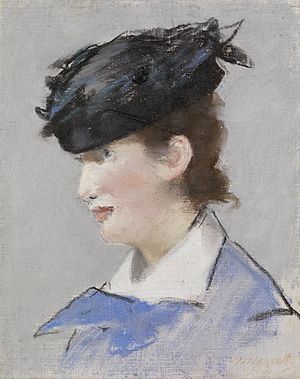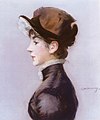Élisa (Manet)

|
| Élisa |
|---|
| Édouard Manet , 1883 |
| Pastel chalk on canvas |
| 25.4 x 20.3 cm |
| Burrell Collection, Glasgow |
Élisa also Elisa , is a woman portrait by Édouard Manet . Theportrait paintedwith pastel chalk on primed canvas has the dimensions 25.4 × 20.3 cm. Depicted is Élisa Sosset, the maid of the courtesan Méry Laurent, who is friends with Manet. Manet created the picture in 1883, a few weeks before his death. The portrait is part of the City of Glasgow Art Collectionsand is on display in the Burrell Collection Museum.
Image description
Manet has portrayed a young woman in this pastel. The portrait, executed as a shoulder piece , shows her bust-shaped upper body from the side. Her face can be seen in profile, her wide-open eyes look to the left of the picture. A light, rosy complexion underlines your youthful appearance. The mouth is closed, the ear uncovered by the red-brown hair. Her slightly wavy hairstyle reaches down to the nape of the neck. The sitter wears a flat, dark hat with subtle feathers pulled up over her forehead. She is dressed in a blue dress with a large bow tied in front of the chest and a closed, wide white collar. The background of the picture is kept in monotone gray. The execution of the portrait appears sketchy and unfinished, especially in the area of the dress, individual lines of the design are recognizable. The signature “Manet” and the date “1882” can be found in the lower right of the picture. This information does not come from Manet himself, but was added to the picture by his wife Suzanne Manet after the painter's death. In doing so, she made a mistake when giving the year, as the picture was not taken until 1883.
A portrait of a maid
The circumstances behind the creation of the portrait of Élisa have come down to us from Manet's friend and biographer Antonin Proust . In his memoirs, he described that Manet had begun the portrait on Easter Saturday 1883 (March 24th) in his studio in the Rue d'Amsterdam in Paris. When Élisa returned for the portrait session the next day, however, the artist was already too sick to meet her in the studio. According to Proust, Manet could not leave his apartment on rue de Saint-Pétersbourg until his death on April 30, 1883. Suzanne Manet found the unfinished portrait of Élisa on the easel in the artist's studio after her husband's death.
Élisa Sosset was an employee of the courtesan Méry Laurent and sometimes as a maid or a servant ( Servante called). On behalf of Méry Laurent, Élisa repeatedly brought small gifts to Édouard Manet. These included flowers, which Manet liked to arrange as still life motifs in his paintings. The result was pictures like roses in a champagne glass that Manet then gave to Méry Laurent and which, like the portrait of Élisa, is now in the Burrell Collection. But Élisa also brought sweets to Manet. Proust reports that there was a bowl of candy from an Easter egg next to Manet's bedside. This was also a gift brought by Élisa on behalf of Méry Laurent. Proust has also described that Élisa repeatedly worried about Manet's health and that he was very fond of the young woman. Manet's words have been handed down: "What a good girl this Elisa is".
Manet's last portraits of women
In the last years of his life Manet created a large group of portraits of women, which he often executed in pastel paintings . Unlike painting with oil paints, the pastel technique offered the artist a spontaneous way of working, which led to faster results. As a result, the portrait sessions could be shortened considerably, which offered advantages for painters and those represented. This was a great relief for Manet, as his unstable state of health barely allowed him to work for long periods. Manet's intense preoccupation with pastel painting in his late work was possibly due to his friend, the painter Edgar Degas , who had created many of his works using the pastel technique. The art historian Gotthard Jedlicka judged Manet's pastel painting, saying that he was “an outsider and amateur. Above all, he wants to be lovable and capture the charm of feminine beauty. "
Manet mainly portrayed people from his circle of friends and acquaintances, as he rejected professional models because of their unnatural attitude. Méry Laurent Modell, a courtesan with whom Manet had been friends since 1876 and who owned a number of his works, sat particularly often. The employer of the domestic worker Élisa appears, for example, in the portrait of Méry Laurent with a black hat from 1882 ( Musée des Beaux-Arts , Dijon), in which the dress is decorated with a bow tied in front of the chest. Such a decorative element can also be found on the dress of Elisa, portrayed by Manet, but here in a much less splendid presentation. The portrait of Méry Laurent in profile , created around 1882, shows Manet's girlfriend with her head turned to the left, a side view that resembles the portrait of Élisa. Other women portrayed by Manet included Suzette Lemaire, the teenage daughter of a friend, and Jeanne Guillemet, co-owner of a fashion store. The pastel picture Suzette Lemaire in profile from 1882 (private collection) and the portrait of Madame Guillemet ( Saint Louis Art Museum ) from 1880 are further portraits of women from the last years of Manet's life, in which he also portrayed the sitter in a bust-like side view.
Provenance
The pastel portrait of Élisa Sosset belonged to Manet's estate. Suzanne Manet, the artist's widow, may have given the portrait to the person depicted shortly after Manet's death. The portrait remained in the possession of Élisa Sosset until around 1902 and then appeared in the Parisian art trade. In 1921 the art dealer Georges Bernheim sold the portrait of Élisa to the Scottish shipowner William Burrell , who owned several works by Manet. He left the picture to the City of Glasgow in 1944, along with his extensive art collection. The Burrell Collection, donated together with his wife Constance, has been in its own art museum since 1983.
literature
- Françoise Cachin , Charles S. Moffett and Juliet Wilson-Bareau : Manet: 1832–1883 . Réunion des Musées Nationaux, Paris, The Metropolitan Museum of Art, New York, German edition: Frölich and Kaufmann, Berlin 1984, ISBN 3-88725-092-3 .
- Blandine Chavanne: Méry Laurent, Manet, Mallarmé et les autres ... . Exhibition catalog Musée des Beaux-Arts Nancy, Artlys, Versailles 2005, ISBN 2-85495-221-9 .
- Paul Jamot, Georges Wildenstein : Manet: l'oeuvre de l'artiste; catalog critique . Catalog raisonné, Les Beaux-Arts, Paris 1932.
- Gotthard Jedlicka : Edouard Manet . Rentsch, Erlenbach-Zurich 1941.
- Hans Körner: Edouard Manet: dandy, flaneur, painter . Fink, Munich 1996, ISBN 3-7705-2931-6 .
- Sandra Orienti: The painted work of Edouard Manet . Kunstkreis, Lucerne 1967.
- Ronald Pickvance : Manet . Exhibition catalog Martigny, Fondation Pierre Gianadda, Martigny 1996, ISBN 2-88443-037-7 .
- Antonin Proust : Edouard Manet, memories . Cassirer, Berlin 1917.
- John Rewald : Edouard Manet, Pastels . Bruno Cassirer, Oxford.
- Philippe Rollet: Collection Burrell: chefs-d'œuvre réalistes et impressionnistes . LienArt, Paris 2018, ISBN 978-2-35906-237-3 .
- Denis Rouart, Daniel Wildenstein : Edouard Manet: Catalog raisonné . Bibliothèque des Arts, Paris / Lausanne 1975.
- Adolphe Tabarant : Manet, histoire catalographique . Éditions Montaigne, Paris 1931.
- William Wells: Manet's Portrait of Elisa in The Scottish Art Review , 1973 Volume 14-15, 8-9.
Web links
Individual evidence
- ↑ As Élisa referred to in Paul Jamot, Georges Wildenstein: Manet: l'oeuvre de l'artiste; catalog critique , vol. 1, p. 183; in addition, the description “Petit portrait au pastel, un esquisse d'Élisa” can be found in Blandine Chavanne: Méry Laurent, Manet, Mallarmé et les autres ... , p. 17.
- ^ In the catalog raisonné by Denis Rouart, Daniel Wildenstein: Edouard Manet: Catalog raisonné , Vol. II, p. 34.
- ↑ On the website of the Museum Collections of the City of Glasgow you can find the indication “primed linen canvas”.
- ↑ The stated dimensions refer to the information on the website of the Museum Collections of the City of Glasgow ; In contrast, Rouart / Wildenstein name the dimensions 25 × 20 cm in Denis Rouart, Daniel Wildenstein: Edouard Manet: Catalog raisonné , Vol. II, p. 34.
- ↑ The year of origin 1883 is noted in Denis Rouart, Daniel Wildenstein: Edouard Manet: Catalog raisonné , Vol. II, p. 34.
- ^ Adolphe Tabarant: Manet, histoire catalographique , p. 506.
- ↑ Blandine Chavanne: Méry Laurent, Manet, Mallarmé et les autres ... , p. 17.
- ↑ William Wells: Manet's Portrait of Elisa in The Scottish Art Review , 1973 Volume 14-15, 8-9.
- ^ Antonin Proust: Edouard Manet, Memories , p. 113.
- ↑ The art historian Hans Körner wrote that the picture "did not thrive to the end" in Hans Körner: Edouard Manet: Dandy, Flaneur, Maler , p. 195.
- ^ William Wells: Manet's Portrait of Elisa in The Scottish art review, 1973, Vol. 14-15, p. 9.
- ↑ The term chambermaid can be found in the German translation of Antonin Proust's memoirs, see Antonin Proust: Edouard Manet, Memories , p. 113; the term Servante can be found in Blandine Chavanne: Méry Laurent, Manet, Mallarmé et les autres ... , p. 17.
- ↑ Blandine Chavanne: Méry Laurent, Manet, Mallarmé et les autres ... , p. 17
- ^ Philippe Rollet: Collection Burrell: chefs-d'œuvre réalistes et impressionnistes , p. 116.
- ^ Antonin Proust: Edouard Manet, Memories , p. 113.
- ^ Antonin Proust: Edouard Manet, Memories , p. 113.
- ^ Charles S. Moffett: Woman with fur, portrait of Méry Laurent in Françoise Cachin, Charles S. Moffett and Juliet Wilson-Bareau: Manet: 1832-1883 , p. 491.
- ^ Françoise Cachin: Mme Manet on a blue sofa in Françoise Cachin, Charles S. Moffett and Juliet Wilson-Bareau: Manet: 1832–1883 , pp. 365–366.
- ↑ Gotthard Jedlicka: Edouard Manet , p. 354.
- ↑ The authors Rouart / Wildenstein state that the picture was a gift from Madame Manet to Élisa, see Denis Rouart, Daniel Wildenstein: Edouard Manet: Catalog raisonné , vol. 2, p. 34; this transfer is also described in Blandine Chavanne: Méry Laurent, Manet, Mallarmé et les autres ... , p. 17; Sandra Orienti, however, suspected that the picture had been a gift from Méry Laurent to Elisa, see Sandra Orienti: The painted work of Edouard Manet , p. 121.
- ↑ Information about the foundation on the museum's website .



